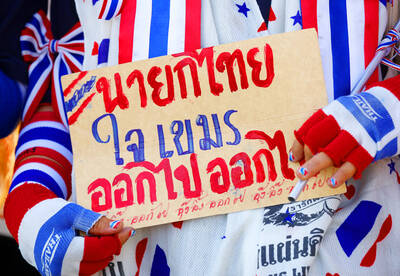Only kilometers from the scenic vistas and celebrity mansions that draw sightseers from around the globe — but a world away from the glitz and glamor — a bus tour is rolling through the dark side of the city’s gang turf.
Passengers paying US$65 a head on Saturday signed waivers acknowledging they could be crime victims and put their fate in the hands of tattooed ex-gang members who say they have negotiated a ceasefire among rivals in the most violent gangland in the US.
If that sounds daunting, consider the challenge facing organizers of LA Gang Tours: trying to build a thriving venture that provides a glimpse into gang life while also trying to convince people that gang-plagued communities are not as hopeless as movies depict.
“There’s a fascination with gangs,” said founder Alfred Lomas, a former member of the Florencia 13 gang. “We can either address the issue head-on, create awareness and discuss the positive things that go on in these communities, or we can try to sweep it under the carpet.”
Several observers have questioned the premise behind the tours, and some city politicians have been more blunt.
“It’s a terrible idea,” City Councilman Dennis Zine said. “Is it worth that thrill for 65 bucks? You can go to a [gang] movie for a lot less and not put yourself at risk.”
More than 50 people brushed aside safety concerns for Saturday’s maiden tour to hear how notorious gangs got started and bear witness to the neighborhoods where tens of thousands of residents have been lured into gang life.
The unmarked chartered bus wound its way through downtown. The first sight was a stretch of concrete riverbed featured in such movies as Terminator and Grease, where countless splotches of gray paint conceal graffiti that is often the mark of street gangs and tagging crews.
After that, it was on to the Central Jail, past Skid Row’s squalor and homeless masses and into South Los Angeles, breeding ground for some of the city’s deadliest gangs.
Motoring through an industrial area, the bus enters the Florence-Firestone neighborhood, close to the birthplace of the Crips and home to Florencia 13, a Latino gang accused by federal prosecutors of racist attacks against black residents.
Sieglinde Lemke, 46, an American Studies professor from the University of Freiburg in Germany, said she enjoyed the chance to interact with former gang members.
“It brings to life the class divisions you have in America,” she said.
Junior high school teacher Prisca Ricks, 37, was of two minds about going on the tour after reading critical blog comments about it being “ghettotainment.”
But she was pleased she went and said she appreciated the focus on helping the community.
Lomas, 45, a respected activist who has worked with the faith-based Los Angeles Dream Center to distribute hundreds of tonnes of food to low-income families across the inner city, left gang life about five years ago.
He says the aim of his nonprofit company is to bring jobs to communities along the route and reinvest money through micro-loans and scholarships, though he’s not sure how the tour will accomplish that. He also eventually wants to start a gallery and gang museum.
He says the tours will create 10 part-time jobs, mainly for ex-gang members working as guides and talking about their own struggles and efforts to reduce violence. The tour is initially scheduled to run once a month.
Lomas faces a quandary as he tries to show the troubled history of the area once known as South Central before politicians renamed it South Los Angeles in 2003 in an attempt to change its deep association with urban strife.
The tour is billed as “the first in the history of Los Angeles to experience areas that were forbidden.” But tour leaders don’t want it to be voyeuristic and sensational.
Out of sensitivity to residents, passengers are banned from shooting photographs from the bus. Also, stretches of the tour have almost nothing to do with gangs, but instead highlight chapters of violence such as a 1974 shootout between police and the Symbionese Liberation Army and the site of the riots that followed the acquittal of officers in the Rodney King beating.

Eleven people, including a former minister, were arrested in Serbia on Friday over a train station disaster in which 16 people died. The concrete canopy of the newly renovated station in the northern city of Novi Sad collapsed on Nov. 1, 2024 in a disaster widely blamed on corruption and poor oversight. It sparked a wave of student-led protests and led to the resignation of then-Serbian prime minister Milos Vucevic and the fall of his government. The public prosecutor’s office in Novi Sad opened an investigation into the accident and deaths. In February, the public prosecutor’s office for organized crime opened another probe into

RISING RACISM: A Japanese group called on China to assure safety in the country, while the Chinese embassy in Tokyo urged action against a ‘surge in xenophobia’ A Japanese woman living in China was attacked and injured by a man in a subway station in Suzhou, China, Japanese media said, hours after two Chinese men were seriously injured in violence in Tokyo. The attacks on Thursday raised concern about xenophobic sentiment in China and Japan that have been blamed for assaults in both countries. It was the third attack involving Japanese living in China since last year. In the two previous cases in China, Chinese authorities have insisted they were isolated incidents. Japanese broadcaster NHK did not identify the woman injured in Suzhou by name, but, citing the Japanese

YELLOW SHIRTS: Many protesters were associated with pro-royalist groups that had previously supported the ouster of Paetongtarn’s father, Thaksin, in 2006 Protesters rallied on Saturday in the Thai capital to demand the resignation of court-suspended Thai Prime Minister Paetongtarn Shinawatra and in support of the armed forces following a violent border dispute with Cambodia that killed more than three dozen people and displaced more than 260,000. Gathered at Bangkok’s Victory Monument despite soaring temperatures, many sang patriotic songs and listened to speeches denouncing Paetongtarn and her father, former Thai prime minister Thaksin Shinawatra, and voiced their backing of the country’s army, which has always retained substantial power in the Southeast Asian country. Police said there were about 2,000 protesters by mid-afternoon, although

MOGAMI-CLASS FRIGATES: The deal is a ‘big step toward elevating national security cooperation with Australia, which is our special strategic partner,’ a Japanese official said Australia is to upgrade its navy with 11 Mogami-class frigates built by Japan’s Mitsubishi Heavy Industries, Australian Minister for Defence Richard Marles said yesterday. Billed as Japan’s biggest defense export deal since World War II, Australia is to pay US$6 billion over the next 10 years to acquire the fleet of stealth frigates. Australia is in the midst of a major military restructure, bolstering its navy with long-range firepower in an effort to deter China. It is striving to expand its fleet of major warships from 11 to 26 over the next decade. “This is clearly the biggest defense-industry agreement that has ever